according to ohms law what would happen to the current if resistance is increased? brainly
In the previous tutorial, we had discussed the applications of current, voltage, and importance of Coulomb's law in electricity. But, without ohms police the performance of an electric circuit becomes incomplete.
To fulfill this, Ohms Law is as well involved. A German language physicist Georg Simon Ohm discovered the ohms police force and found the relationship between current, voltage and resistance.
In this tutorial, you will know how to apply ohms law to different applications of electric and electronics engineering.
As you know, Electric electric current flows in the form of charged electrons. In other words, less catamenia of electrons ways high resistance is present in the excursion. And, the high menstruum of electrons means depression resistance is present.
Electron current is the number of electrons moving per second. However, for practical applications, nosotros need less amount of electron charge. To simplify, two measuring units known as Ampere and Coulomb have been used.
The coulomb indicated by 'Q' expresses an adequate amount of electric accuse.
Electrical Accuse is equal to 6 one thousand thousand electrons multiplied by 1 one thousand thousand electrons. This resultant charge is again multiplied by i million electrons.
The Ampere represented past 'A' is the strength of unit of measurement current or the number of electrons traveling per second, in this case, i coulomb per second.
An Ampere is too large for some of the applications. So, it is again divided into subparts known equally milli-ampere (mA), and the micro-ampere (µA).
1 A = 1000 mA = 1,000,000 µA 1 mA = 1/chiliad A = 1000 µA
Now let us discuss resistance. Since the limerick of various materials is different, some materials offer high opposition to the flow of electrons than other metals. This electrical phenomenon is known every bit resistance.
At present, if we utilise driving strength or Electromagnetic force (East.G.F) across a usher, a keen number of electrons will menses rapidly. This proves that resistance of the usher is low.
On the other hand, applying same E.Grand.F to an insulator will produce fewer electrons. Hence, the resistance of an insulator is high.
The resistance is expressed in Ohms and denoted by the Greek capital letter 'Ω'. The unit of measurement of E.M.F is the Volt. One Volt is the driving strength necessary forcefulness required to produce a current strength of 1A in a circuit having a resistance of one Ω.
The electrical current is a measuring instrument chosen Ammeter and electrical resistance is measured using Ohm meter.
How Ohm'southward Law work?
Ohm'south police force relates the electrical quantities such as electric current, voltage, power and resistance. To know the practical use of the ohms police hither is an example.
Connect a wire of certain resistance, in serial with 1.5V battery source and assume that ammeter indicates a current of 0.2A. Now, if we increase the voltage to 3V, the electric current meter will show more current reading, say, 0.4A.
This states that past keeping the resistance as abiding and increasing the voltage, the current will exist doubled. Past repeating this process of increasing and decreasing voltage by keeping the resistance unchanged the voltage will be proportional to the current.
A similar thing happens if we change the length of the usher wire, keeping the practical voltage as constant.
If we change the length of wire to shorter or longer, it has some outcome due to the resistance of the wire.
For example, past applying abiding E.1000.F of one.5V and the length of wire is 2m, the electric current drawn is 0.3A.
Now, if we change the length of the wire to 1m, the electric current will be lesser 0.1 (just non 0.three) considering of less distance to comprehend and less resistance to overcome.
Ohm'due south Law Theory
When you take a metallic conductor and menses some current through it, the potential difference between the two ends of a conductor is constant.
Definition of Ohms Law
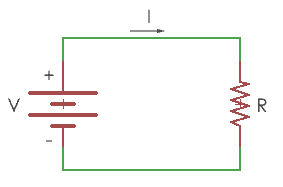 Ohms police states that "the current flowing through an electrical excursion will modify when a voltage is applied, but the resistance is inversely proportional to the resistance of the conductor textile".
Ohms police states that "the current flowing through an electrical excursion will modify when a voltage is applied, but the resistance is inversely proportional to the resistance of the conductor textile".
The formula of ohms constabulary is represented by the equation
Five=IR
'V' is the potential drop(voltage) across the resistor.
'I' is the current flowing in the circuit through the resistor
'R' is the resistance value of resistor represented in ohms.
The to a higher place equation, I=V/R depicts the following facts.
- Electric current alters with the applied input voltage
If the resistance of the usher is kept constant, the voltage volition increase with an increase in current and the voltage will decrease with a decrease in current.
- Current and resistance are inverse to each other
Now proceed voltage in the circuit every bit a constant parameter, If you change the resistance, the current volition likewise vary.
For suppose, if the resistance is increased, the electric current in the circuit is decreased and if the resistance is decreased the current will increment.
- Voltage and Current relation
The relation between voltage and current is linear. i.e. with larger voltage, the current will be higher and lower current for smaller voltage.
Ohms Law Analogy
The relationship between voltage, current, and resistance tin can be known by finding the third quantity from the known two values.
The two known values may be either voltage, current or resistance.
Adding of Ohms Police
Ohm's law tin be represented in three forms. To sympathize simply, ohms law circle or ohms law Triangle is used in electric circuits to discover out the third quantity of the ii other quantities.
The circle or triangle method is used for memorizing the ohms law.
Hither I am using ohms law circle to notice out voltage, current, and resistance.
- To calculate the Voltage (V), round of the voltage (Five) every bit shown below. The current and resistance are related.
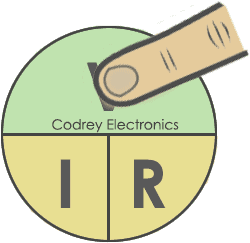
V= I x R
- To calculate the Electric current (Amperes), round of the Current(I) equally shown below. This will be the electric current flowing in the excursion.
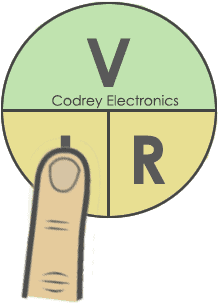
I = V/R
- Similarly, to find out the resistance (ohms), round of the resistance(R), you will go the resistance of the conductor.
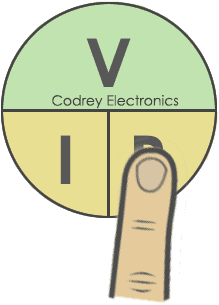
R = Five/I
By combining voltage, current, and resistance we can get a common relationship to draw the ohms police force graph.
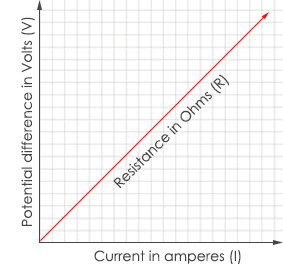
From the graph, if the current in an electrical excursion increases voltage increases linearly and vice versa.
To brand the relation easier Ohms police force Table is given for quick reference.
| Ohms Law | Known Values | Human relationship one | Relationship 2 |
|---|---|---|---|
| Five=IR | Current and Resistance | Voltage is direct proportional to current | Voltage is directly proportional to resistance |
| I=V/R | Voltage and Resistance | Current is inversely proportional to resistance | Current is directly proportional to Voltage |
| R=V/I | Voltage and current | Resistance is directly proportional to voltage | Resistance is inversely proportional to electric current |
Now, let united states of america know how to use ohms law formulas in a practical way.
Examples of Ohm's Law
i. Finding the electric current in a circuit
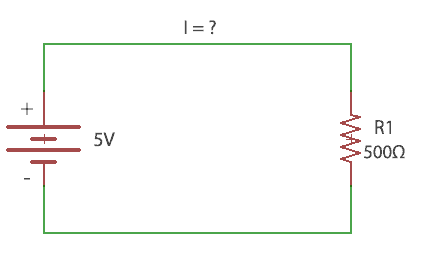 Given: Voltage=5V , Resistance=500Ω, I=?
Given: Voltage=5V , Resistance=500Ω, I=?
Formula:
I=V/R = 5/500= 0.01A.
Then, by applying 5V potential a current of 0.01A flows through the 500 ohms resistor.
2. Finding the voltage in a circuit
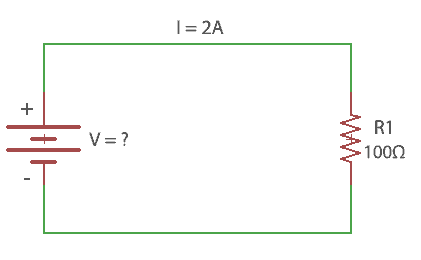 Given: Resistance=100Ω, I=2A, Voltage =?
Given: Resistance=100Ω, I=2A, Voltage =?
Formula:
V=IR = 2*100=200V
So, the bombardment voltage for the circuit is 200V.
3. Finding the resistance in a circuit
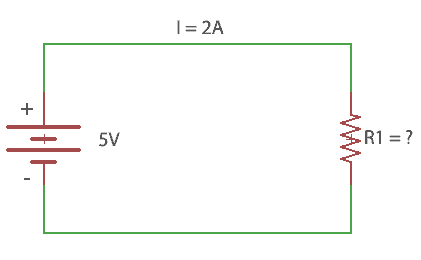 Given: I=2A, Voltage = 5V, Resistance =?
Given: I=2A, Voltage = 5V, Resistance =?
Formula:
R=V/I = 5/2=2.5Ω
So, a resistance of ii.five ohms has to be connected in serial with the battery source.
Practical applications of Ohm'south Constabulary
1. Power Supply design (every bit voltage divider)
Ohms law is useful in designing power supplies for the electronic circuits. Voltage dividers decide the regulated output for proper function of the circuit. This is accomplished by choosing correct resistance using the ohms law.
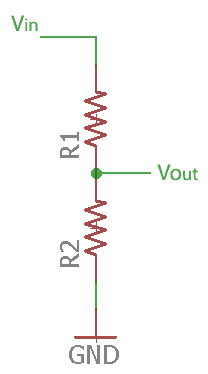
2. Analog sensors
Some types of sensors gives electric current reading as output. For example, radar sensor gives a current output of 4-20mA.

This electric current output should exist converted to a voltage using resistance equation. The obtained analog voltage is then processed through ADC (Analog to digital converter).
3. Speed Control
Ohms police force is extensively used in speed controlling applications. It is used in potentiometer also known equally "POT". The knob resistance is varied slowly, which increases the voltage and rotates the motor or fan.
4. Simplification of circuits
It is also used in the reduction of circuitous electrical circuits using Kirchhoff's Voltage Police and Kirchhoff's Current police equation. A series and parallel circuits can exist realised but using ohms police.
Conclusion
Information technology is important in real life to notice out the current and voltages for any awarding. A small deviation in the output load may burn or damage the circuit. To avoid this, it is required to apply the principles of ohms law and build a valid electronic system.
Source: https://www.codrey.com/dc-circuits/ohms-law-basics-voltage-current-resistance/
0 Response to "according to ohms law what would happen to the current if resistance is increased? brainly"
Post a Comment